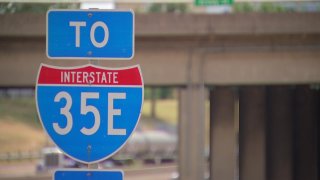
If you’re driving to San Antonio to see the Alamo, to Austin to go to a music festival, to Dallas or Fort Worth to see the Cowboys or visit the Stockyards, odds are you’ll be on Interstate 35.
"Interstate 35 is Main Street, Texas," said Michael Morris, the director of transportation for the North Central Texas Council of Governments.
But “Main Street” opened in the 1960s, which means parts of it are already more than 60 years old. The solution to those problems so far has been about two decades of major road work up and down the I-35 corridor, through four of the state’s five largest cities.
Get top local stories in DFW delivered to you every morning. Sign up for NBC DFW's News Headlines newsletter.
"I'm not sure who came up with the idea that once you finish construction on a highway, it's done," Texas Department of Transportation spokesperson Kenna Mitchell said. "There's a certain life that comes with the highway. You get impacted by weather conditions, by traffic conditions. And then also within the pavement or bridges itself, there are different elements that come into play that have a life cycle of their own."
According to the U.S. Census Bureau, the population of Texas eclipsed 30 million people last year – and from 2000 to 2022, the state added more than nine million residents to grow by 43%, making if the fourth-fasting growing state in the country. State Rep. Ramon Romero (D-Fort Worth), who sits on the House Committee on Transportation, said he thinks the state gave too much control to private entities as it's expanded its roads.
"Did we do a good job? No. Could we have done better? Absolutely. Did we get new roads? Yes," he said. "But I'm very concerned that we're partnering with for-profit companies and their responsibility is not to you and I, the taxpayers and residents, their responsibility is to the shareholders.
It's not just North Texas, where I-35 has impacted residents. In Waco, four years of construction just finished on part of the interstate. The Waco Herald-Tribune reported in mid-June that the final phase of construction on Interstate 35 in Waco could start as soon as 2024.
"We thought there would be this big break in between. And, you know, I think we're all just like, 'Rip the band-aid off and let's get it done,'" Baylor University assistant vice president of media and public relations Lori Fogleman said. "I think we all know our alternate routes. We know what the construction does with that, and what happens when you improve infrastructure through the city. I think we are all ready for that one last area to be done."
But as we look further south to Austin, where a $4.5 billion dollar project is slated to begin in 2024, not everyone thinks adding more lanes is the most efficient way to go.
"A boulevard with bus lanes, bike lanes, and some car lanes would actually move a lot more people," said Adam Greenfield, board president of the group Rethink 35, which advocates for a different use of the land. "Highways are actually very poor. Movers of large numbers of people because cars are very space inefficient. They lock up in congestion. That's a basic-level bug that they have."
Listen to Texas Wants to Know in the Audacy app or wherever you get your podcasts.




